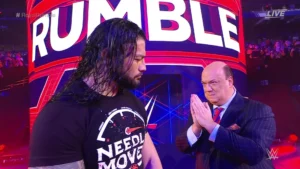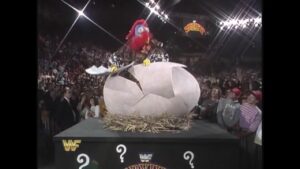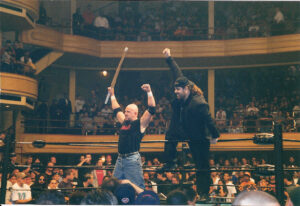Last night, unsurprisingly, the WWE added a Women’s Battle Royal to WrestleMania 34, to continue the Women’s Revolution of giving women the same opportunities and gimmick matches that the men have, similar to how they’ve received a Royal Rumble, Hell in a Cell, Money In The Bank, and Iron Man Match. But while the Battle Royal itself as a concept is another step forward, the naming of the Memorial Battle Royal after former Women’s Champion The Fabulous Moolah is unto itself a monumental step back. In this day and age where fans can Google the histories of former Superstars, naming an annual match that will be seen by the most amount of fans per year after a woman such as Lillian Ellison is both shocking and disappointing to say the least. For those in the know (which in today’s day and age seems to be most die hard wrestling fans), no explanation is necessary why this is such an insulting move. But for those who simply know of The Fabulous Moolah as the woman who held the Women’s Championship for the bulk of the 1960’s through 1980’s, here’s a little refresher. And then you can decide if she deserves the same accolades as the men’s counterpart, Andre the Giant (EDITOR’S NOTE: You can read a lot more on the subject in Pat Laprade and Dan Murphy’s fantastic history of women’s pro wrestling, Sisterhood of the Squared Circle: The History and Rise of Women’s Wrestling)
"On the heels of the Warrior award and the Fabulous Moolah battle royal, WWE is pleased to announce the Fritz Von Erich Father of the Year trophy."
— Trevor Dame (@TrevorDame) March 13, 2018
THE FABULOUS MOOLAH: In The Beginning

Born in South Carolina in 1923, Moolah’s saw tragedy at a young age when her mother died when Moolah was only eight years old. To cheer her up, her father began taking her to local wrestling matches. Seeing Women’s Champion and WWE Hall of Famer Mildred Burke inspired her to chase the dream of one day becoming a wrestler – and Women’s Champion – herself. In 1948, she began training with Burke’s then-husband, notorious women’s promoter Billy Wolfe. Wolfe was infamous for his abusive relationship with his women trainees and stars, often sleeping with them in exchange for spots on his cards. This abusive relationship ultimately let to Mildred Burke finally leaving him, where she was blackballed in most of North America. Burke headed to Japan in the early 50s and laid the foundation for women’s wrestling in the East (her WWA laid the groundwork for All-Japan’s Women’s Pro-Wrestling). Moolah would only last a year in Billy Wolfe’s camp before the abuse took its toll on her. She ventured out on her own in 1949. She soon assembled her own crew of girls, but Wolfe’s stranglehold on the North American circuit made finding work hard.

Her big break came when Boston promoter Paul Bowser agreed to use Moolah’s girls instead of Wolfe’s for his cards, and soon other Northern promoters followed suit, including Vince McMahon Sr.‘s Capitol Wrestling in 1955. In 1956, these promoters – all NWA allied – announced a tournament to crown their own Women’s Champion – away from Wolfe’s designate – and The Fabulous Moolah was their woman.
THE FABULOUS MOOLAH: The Dark Side of the Monopoly

Sadly for women’s wrestling – which had been a main event draw for years during the 1930s through 1940s – the Fabulous Moolah, while rejecting of Wolfe’s tactics, turned to most of them throughout her own career. She had worked out a deal where she owned the NWA Women’s Championship title and booked it herself wherever she went. In doing so, she monopolized the title to herself. She held the NWA Women’s title four times in the near 30 years she controlled it’s booking and lineage, dropping it only a handful of times. Once for 13 days to Bette Boucher in 1966 (ten years into her first reign), once on a Japan tour to Yukiko Tomoe for 23 days (she won it back at the end of the tour) in 1968, and finally to Evelyn Stevens for two days in 1978. In total, she held it for over 11,000 days from 1956 to 1983, before she signed exclusive to Vince McMahon Jr.‘s WWF, in a deal that saw her sell the Women’s Championship to be used by the WWF (who immediately took it off her and put it on Wendi Richter). During those three decades, pioneers of women’s wrestling such as Judy Grable, Penny Banner, and even her hero, Mildred Burke, and best friend, Mae Young, were denied the opportunity to wear the championship gold.
THE FABULOUS MOOLAH: Moolah’s Girls

For decades, both prior to and after her death in 2007, women wrestlers have come out of the woodwork to question not only Moolah’s jealous monopolization of the NWA Women’s Championship, but her work ethics as well. For someone who left Billy Wolfe for his own abusive tendencies and mistreatment of women’s wrestlers, Moolah seemed to only take the worst of Wolfe’s lessons with her when she left.
“Moolah, however, could have changed things by running an honest syndicate, training and booking women on the level. She could have broken the patterns established by Wolfe. She chose not to. Maybe it was just too deeply ingrained.” Tim Hornbaker, wrestling historian, in an interview in Sisterhood of the Squared Circle: The History and Rise of Women’s Wrestling (Pat Laprade, ECW Press, 2017)
From a business perspective, Moolah was arguably the most successful women’s wrestling trainer in the country, if not North America. Girls flocked from all of the country to work with her. But they soon found out that it was a long way to the top if you wanted to go through Moolah. It was ironic that for a woman who began her career as “Slave Girl Moolah”, she made almost all of her “girls” into slaves themselves. The girls had to stay on Moolah’s compound in quarters that she rented out to her trainees and stars – they also had to pay their own utilities. And they only got paid what Moolah felt like paying them. She took anywhere from 25% to 50% off their booking pay as a “finder’s fee”, and even then, she was notorious for skimming more off the top for herself. Women were constantly discovering they’d earned far less than they’d been promised for an appearance. And while Moolah controlled the NWA Women’s title, she would let the promoters she booked her girls with control over the women’s matches on their card – and it was often determined by what the girls offered in exchange. This horrible abuse of power wasn’t just something that Moolah was aware of, but something she seemingly encouraged and promoted.

In her later years, one of the early days’ legends, Penny Banner, finally broke her silence online about her long time adversary Moolah following Moolah’s death in 2007:
“It’s wrong to speak bad of the dead, but the comments in the mainstream press and even AP wires come dangerously close to making Moolah seem like some kind of saint, and from a pro-wrestling point of view as some kind of legendary tough shooter. That’s utter bullsh*t. I want to clear up a couple of points, while taking nothing away from Moolah’s ability to have a stranglehold on women’s wrestling from mid ’60s to mid ’80s in North America.
Let’s get this out of way first, so I don’t have to dance around the subject – Moolah was a pimp. From her sprawling 42 acre estate in Columbia, South Carolina, Moolah would send out her half-trained underage female-wrestlers to “photo shoots” that would by the standards of today be considered pedophilia and pornography. She sent trainees to wrestling promoters in set numbers. Renting them out to promoters in bulk, with the understanding that the girls would have sex with the promoter and all the wrestlers on the roster who wanted them. Promoters liked free sex, but what they also liked is for boys not to go outside looking for it and possibly running into trouble. Sex on a road with a steady and pliant group of semi-attractive women in return for money, that is what Moolah offered. The women that were sent out on this tours were not told of this “arrangement” ahead of time. They found out about it on the road. Those that refused to have sex with promoters and wrestlers, were raped. The reason women’s pro-wrestling in North America was and still in large part today considered a joke and just an opportunity to ogle at tits and asses is largely in part thanks to the way Moolah trained her girls and how Moolah wrestled. Moolah was not a good worker. Her wrestling style considered of hair pulling snapmare, headlocks, clotheslines and nothing else. Those that argue that women’s wrestling was always like that and Moolah did nothing to change it are ignorant. In the ’30s and ’40s, female wrestling employed shooters and they wrestled in the traditional sense of the term. Tits and asses were used to advertise and get them in the building, but the girls worked longer and more technically sound matches than today. The champion was always a shooter, and the matches for the championship and leading up to the main event had to be high caliber. The reason Japanese women’s wrestling was light years ahead of North American’s is because of one person and one person only – Moolah. Mildred Burke, the original women’s champion, popularized female wrestling in the world in the ’30s. Japan, Canada, Mexico and America can trace women’s wrestling directly to her. She used a hard hitting style and outside of being an attractive woman, her matches were no different from the men’s matches of her day. Moolah was inspired by Burke, but could not work as well as her. Moolah was not a good worker and so the style she passed onto her trainees once she took over women’s pro-wrestling in North America was Moolah-based. Moolah was never a shooter.”
THE FABULOUS MOOLAH: The Original Screwjob
While most WWE fans are quite aware of the infamous Montreal Screwjob involving Bret ‘Hitman’ Hart and Shawn Michaels, the WWF’s first screwjob occured years prior and it was at the hands of the Fabulous Moolah. And while Vince McMahon was clearly a part of the Montreal Screwjob, they weren’t even aware of Moolah’s until it was too late.

With the rise of the WWF in the 1980s, there was one set of titles that the WWF had yet to fully push and that was the WWF World Women’s Tag Team titles. Established in 1983, they were used sparingly on Live Events. In 1985, The Glamour Girls, a duo that featured two of Moolah’s “girls”, Leilani Kai and Judy Martin, won the titles and began a three year tenure with the belts. In 1987, they entered an amazing feud with a Japanese import team, The Jumping Bomb Angels (Itsuki Yamazaki & Noriyo Tateno) that would last over a year. The feud was so hyped that the Angles finally defeated the Glamour Girls for the titles in a Best 2-out-of-3 Falls Match at the inaugural Royal Rumble in 1988. The WWF was ecstatic about these innovative Japanese women (whose careers had been inspired by another former Billy Wolfe protegee in Mildred Burke), who were bringing some of the best wrestling – men or women – to the WWF’s increasingly expanding international presence. According to Leilani Kai, thanks to Moolah’s jealousy over being cut out of the business dealings of her women on the WWF roster (she no longer received the finder’s fees she was accustomed to), she decided to sabotage everything. While both teams were on a friendly tour of All Japan Women’s Pro-Wrestling in 1988 following the Royal Rumble, Moolah called the AJW promoter and insisted that the WWF wanted The Glamour Girls to recapture the belts in Japan. So June 8, 1988, they did just that. It was a travesty. The Japanese were accustomed to their stars defeating the foreign wrestlers on their turf – anything else would be a sign of disrespect. But the promoters were bound by the WWF’s wishes as they were still effectively using their talent. But when Pat Patterson found out what had gone down in Japan, he was furious. Patterson was oblivious to Moolah’s actions and assumed that the Glamour Girls themselves had called the audible to take back the belts – due to Moolah’s long standing history with the McMahon family, Moolah received no repercussions. But in almost seeming retribution for the Japan incident, the Women’s Tag Team titles were soon retired. Moolah left the WWF shortly after.

THE FABULOUS MOOLAH: The Memorial Battle Royal
It is for all of these reasons, her jealousy, her financial blackmailing of her students and stars alike, and her alleged “whoring” of her “girls” to shady promoters and unscrupulous wrestlers, that many historians and learned fans are appalled that the WWE would stoop to naming a Memorial Battle Royal after someone with such a blackmark on her history. While the WWE is trying so hard to promote its Women’s Revolution of wrestling in the WWE, they chose the one woman who spent thirty years trying to stop the Women’s Evolution of wrestling to represent it.

Looking to talk wrestling, pro football, or any number of sports? Head on over to the LWOS Boards to engage in conversation with fellow fans!






